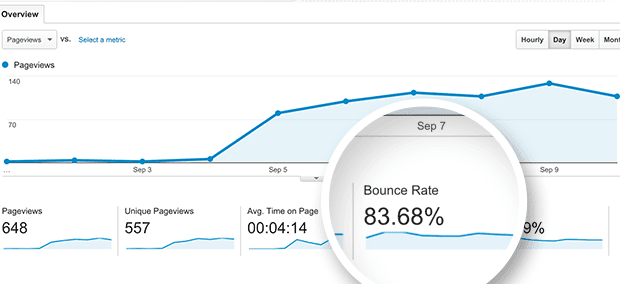Bounce rate is an important metric.
Most website owners and bloggers completely neglect it, but a low bounce rate is crucial for the success of your website.
In this blog post, we are going to discuss several very effective tips on how to reduce your website’s bounce rate.
But first of all, let’s start from the basics.
What is “Bounce Rate”?

If you don’t know anything about it, here is a simple definition for you.
“Bounce rate shows you the percentage of website visitors who leave your website after landing on just one web page. In other words, they quit the website without clicking on any other link.”
Also, there is a major difference between bounce rate and exit rate — which most people often get confused with.
The bounce rate is a percentage of single page visits. However, exit rate just shows the number of people who quit your website. They may have already visited other pages, but the exit rate doesn’t show you that.
As a matter of fact, we have written a very detailed and comprehensive blog post on all the important concepts about bounce rate. It contains in-depth information about almost everything that you need to know about it.
Here is a link for it. Click the following post if you first want to learn more about bounce rate, its basic concepts, and how it affects your website and online business.
Everything You Need to Know About Bounce Rates
Done with it?
Now, let’s see how you can reduce the bounce rate of your website and increase its SEO rankings, engagement, and overall conversions.
Tip #1: Improve Your Website’s Loading Speed
As you know that the loading speed of your website is now a crucial search engine ranking factor. More importantly, a slow-loading website negatively affects the bounce rate of your site.
The attention span of an average internet user is getting lower. They don’t want to spend any extra time waiting for information. This is why when internet users land on a website that doesn’t load within the first 2–3 seconds, they quit it right away.
A slow-loading website does not give them any opportunity to browse other web pages, which eventually leads to a low bounce rate. Use our website speed test tool for free to know the average loading speed of your site.
Tip #2: Write Better Headlines
If the headlines of your blog posts are interesting, engaging, and helpful, your website is more likely to have a low bounce rate.
Why?
Because well-crafted and engaging headlines attract the attention of your readers. Such headlines encourage your website visitors to click and read more articles on your website. As they click and read more posts on your website, your site’s bounce rate starts improving.
Here is an example of how CopyBlogger does it with some really great and interesting headlines in the sidebar widget.
Tip #3: Avoid Clickbaits
Writing great and interesting headlines is important. However, you must not resort to clickbaits - which are capable of doing more harm than good.
After being exposed to too many clickbait articles, the average internet user is getting smarter about it.
Online users now have a great eye that easily filters helpful and useful content from clickbait posts that don’t add any genuine value. Here is an example that shows multiple clickbait articles. Would you click on any of them?
If you are an average internet user, you would know that clicking on these links will lead you to some of the worst websites on internet. Those websites would be filled with annoying pop-ups and hidden ads. And the content just won’t add any value.
To improve bounce rate, make sure to avoid clickbait links on your website. The headline of a post must deliver on the promise, and the content itself must add genuine value to your users’ lives.
Tip #4: Avoid Too Many Pop-Ups
Does your website have too many pop-ups?
If yes, it can be a potential reason of a high bounce rate.
Greeting your website visitors with annoying and on-your-face pop-ups is a recipe for disaster. If someone clicks on an article and lands on your website, she wants engaging and helpful content. She definitely does not want to fill unknown sign-up forms and click on irrelevant banners and ads.
It’s good to have an email marketing strategy, but you will have to be smart about it. Don’t greet your users with pop-ups. Instead, be smart and use the exit-intent technology to show those pop-ups.
My advice would be to base your email marketing strategy around content upgrades, sidebar widgets, and exit-intent popups.
This framework will not only help you get more email subscribers, but it will also help you improve your site’s bounce rate.
Tip #5: Greet Users With a Clear Message
It may seem harsh, but internet users like to create an impression of a website in just the first couple of seconds. They just glance on a website and decide whether they want to spend more time browsing it or quit it right away and jump to another website.
This is why it is so important to greet your website visitors with a very clear message, headline, graphic, and call-to-action.
Give them exactly what they expect or be interesting and curious enough to hold their attention. Otherwise, they will jump off your website and result in an instant increment in bounce rate.
Here is an example of how Time Doctor greets its users with a very clear and crisp message.
If you want to create an interesting message, you are going to need three things:
A well-crafted and intelligent headline to hook your readers
A clean, crisp, and beautiful design which is not distracting at all
And a very clear call-to-action that resonates with the demands and needs of your target audience and website visitors.
Tip #6: Focus on an Internal Link Strategy
Using internal links on your website is a great technique to boost your site’s SEO. However, it is also a great way to keep your visitors for a longer time on your website - which, eventually, translates into better bounce rate.
You should have a proper strategy for creating internal links on your website. Make sure to focus on only creating internal links to relevant articles that your users would find helpful. Track those links to see how they are performing and whether you will need more such links.
If you have a properly laid-out nest of internal links within blog posts, you will notice that the bounce rate will eventually improve to a very respectable level.
Tip #7: Being Careful With External Links
There are two types of links you create within a post: internal links and external links.
And both of these links are important in their own ways.
Internal links help you hold your visitors for a longer time on your website while also increasing page views on other related articles. On the other hand, external links help you build relationships with other bloggers and website owners. Moreover, external links are also considered important for providing genuine and in-depth value to your users on a given subject.
However, you must be very careful with external links as they can significantly increase the bounce rate.
This is because when your readers click on an external link in your blog post, they are redirected to someone else’s website. If they start browsing their content and quit your website, you will have a high bounce rate.
Given said that you can’t completely ignore external links as they are an essential part of a high-quality blog post.
There are two tips that I can share with you about inserting external links for creating a nice balance between providing value to your users and keeping your bounce rate in check. These tips are:
Don’t include too many external links in the beginning of a blog post. First, let your content hook the readers in and grab their attention. Once they are completely awed by the usefulness and quality of your post, only then start sharing relevant external links.
Secondly, whenever you create an external link, make sure you set it to “open in a new window”. Otherwise, if someone clicks on an external link, she will be redirected to the other website, and your site will be automatically closed. You don’t want that.
Tip #8: Proper Formatting
It does not matter how useful and great your content is, if it does not have proper formatting, it won’t be able to retain your users for long.
Internet users make quick judgement about a site’s design, readability of the article, and formatting of a blog post. First impressions do matter here.
The tip is to not create a huge wall of text that is hard to read. Instead, format it with all the given elements in a nice, readable way.
Always use shorter paragraphs and sentences to improve the the flow of reading. Moreover, take help from headings, sub-headings, bullet-points, images, videos, highlighted texts, and other interactive elements to make your posts more engaging, beautiful, and attractive.
Final Words
Bounce rate is important.
Although it does not directly affect your website and user-experience, it has ultimately has a very tangible impact.
A low bounce rate is important for increasing user-experience, search engine rankings, and conversion rates. The tips I’ve mentioned in this article will help you in reducing high bounce rate of your website.
